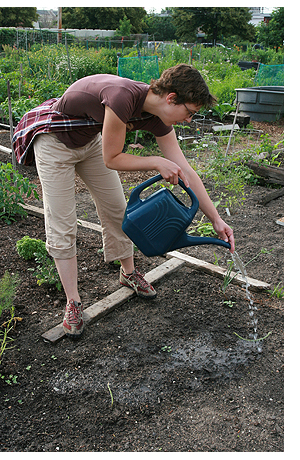| Sun | Mon | Tue | Wed | Thu | Fri | Sat |
|---|---|---|---|---|---|---|
| 1 | 2 | 3 | 4 | 5 | ||
| 6 | 7 | 8 | 9 | 10 | 11 | 12 |
| 13 | 14 | 15 | 16 | 17 | 18 | 19 |
| 20 | 21 | 22 | 23 | 24 | 25 | 26 |
| 27 | 28 | 29 | 30 | 31 |
CATEGORIES
RECENT ENTRIES
BLOG ROLL
New road to hoe
When word came down a few months ago that the 61st Street Community Garden was slated to be dismantled at the end of October, gardeners Mikael Karlstrom, AM'90, PhD’99, and his wife Beth Browning, AM’89, MSW’98, began planning to move to a different neighborhood. “The garden has been the greatest single factor keeping us in Hyde Park the past few years,” Karlsrom says. Longtime Hyde Parkers and University employees, he and Browning, along with their seven-year-old daughter, have kept a plot since 2006, growing tomatoes, raspberries, greens, peas, and beans. “There’s such a sense of connection with nature and community energy at the garden. Everyone’s holding onto some kind of hope that somehow this won’t happen.”
 That hope is, admittedly, slim. The University owns the parcel on which the community garden’s 143 ten-by-ten-foot plots sit, and ten years ago when the place was vacant administrators invited a few community members to establish a garden. The agreement was always temporary, though, and the University has decided it needs the land back. Next spring, when construction begins next door on a new home for the Chicago Theological Seminary, the garden will be converted into a staging area for the project. On October 30 the garden will officially close, and two weeks after that the gardeners must move all their belongings off the lot.
That hope is, admittedly, slim. The University owns the parcel on which the community garden’s 143 ten-by-ten-foot plots sit, and ten years ago when the place was vacant administrators invited a few community members to establish a garden. The agreement was always temporary, though, and the University has decided it needs the land back. Next spring, when construction begins next door on a new home for the Chicago Theological Seminary, the garden will be converted into a staging area for the project. On October 30 the garden will officially close, and two weeks after that the gardeners must move all their belongings off the lot.
The outcry from gardeners has been intense, and organizers Jack Spicer and Jamie Kalven, U-High'65, spent months trying to persuade the University to rethink its plans, to find an “elegant solution,” as Kalven calls it, that would spare the garden while allowing the construction to go forward. University officials offered to help the gardeners find a new location and move their topsoil, but they remained firm on their plans: no alternatives exist to closing the garden. Surrounded by three schools within a two-block radius and hemmed in by the University Press building, a University steam plant, and a busy Dorchester Avenue, the construction site offers few options, says Sonya Malunda, the University’s associate vice president for civic engagement. “We have a responsibility to make sure everyone is safe,” Malunda says, “whether they’re on site or nearby.”
Negotiations with the University are no longer active, Kalven says, though he, Spicer, and other gardeners still hope the place will be saved. In the meantime, Kalven, a journalist, last week began posting an online “live documentary” on the garden, featuring “The Garden Conversations,” two- to five-minute interviews with gardeners standing amid the verdant lushness of sunflowers, pole beans, tomato plants, corn stalks, peppers, and marigolds.
In the videos Debra Hammond, AM'90, MBA’95, describes how the garden helped temper her once-corporate existence: “It’s really changed me,” she says. “It teaches you about food, and it teaches you about yourself.” Marvin Hoffman and Rosellen Brown describe summers full of “garden meals” supplemented by the 61st Street farmer’s market, which along with Experimental Station next door to the east, forms a kind of "synergy," Hoffman says, with the garden. Leaning on a rake, retired Army veteran and first-time gardener Mike Slatton describes the bounty he shared with his Woodlawn neighbors: red cabbage, golden potatoes, sweet corn, watermelons, string beans, collards, kale, five varieties of tomatoes, and more. “I got three celery plants—big celery,” Slatton says. “I fed people celery all summer long.”
According to Kalven, one purpose of "The Garden Conversations" is to show how "the garden speaks in multiple voices" and articulate its meaning and value, not only to the gardeners, but to its neighbors, including the University. The videos are part of an ongoing effort, he says, “to describe and evoke what is unrelocatable about the garden, and what we’ve been nourished by all these years.”
Praising the work the gardeners have done, Malunda says she's sympathetic to their sorrow. But she hopes that in the end they'll take their trowels and trellises to another site. Gardeners say they can't "just pick this up and replicate it somewhere else,” Malunda says. “And I get that. But you also have vacant lots in the neighborhood that need community-building. What about them?”
Lydialyle Gibson
October 16, 2009
